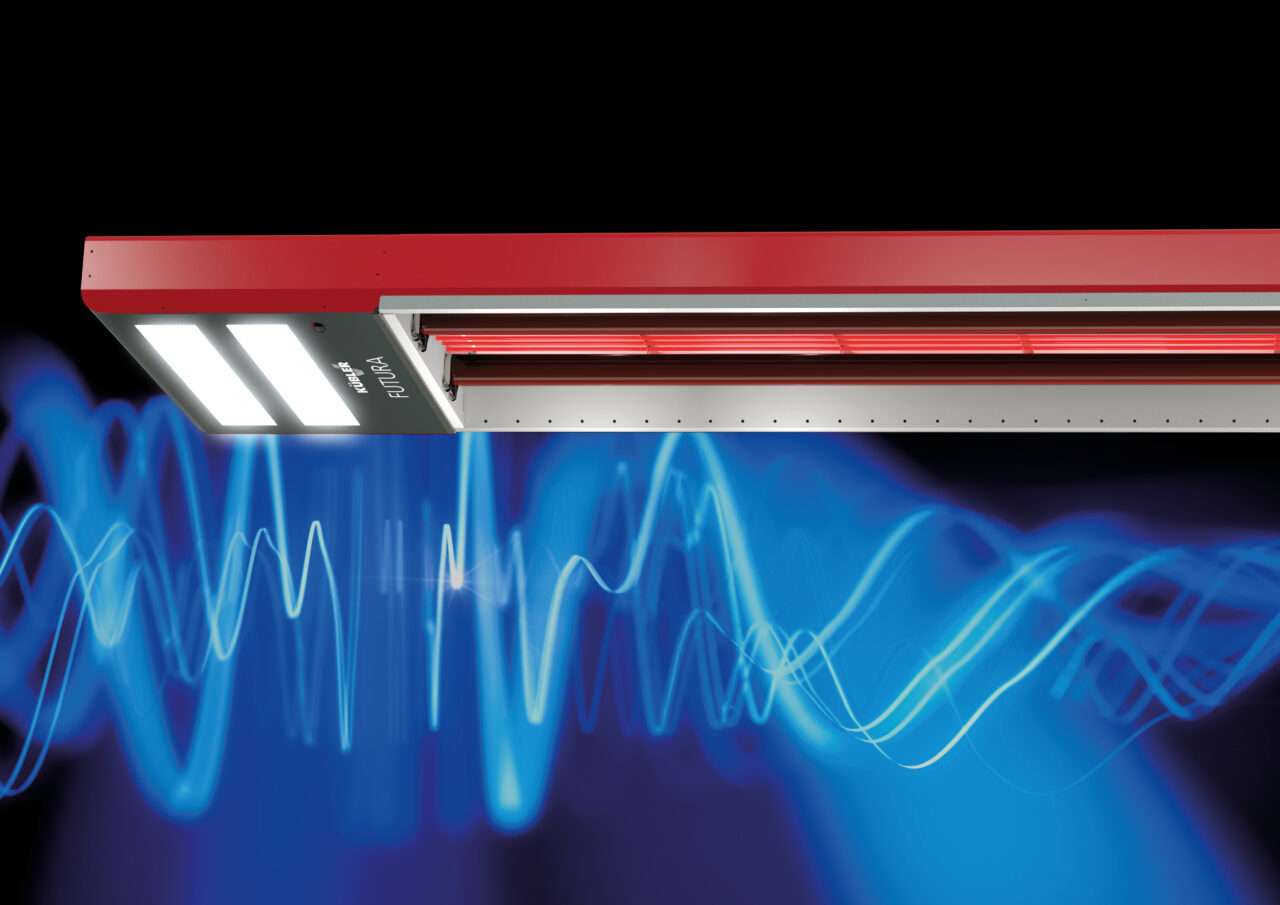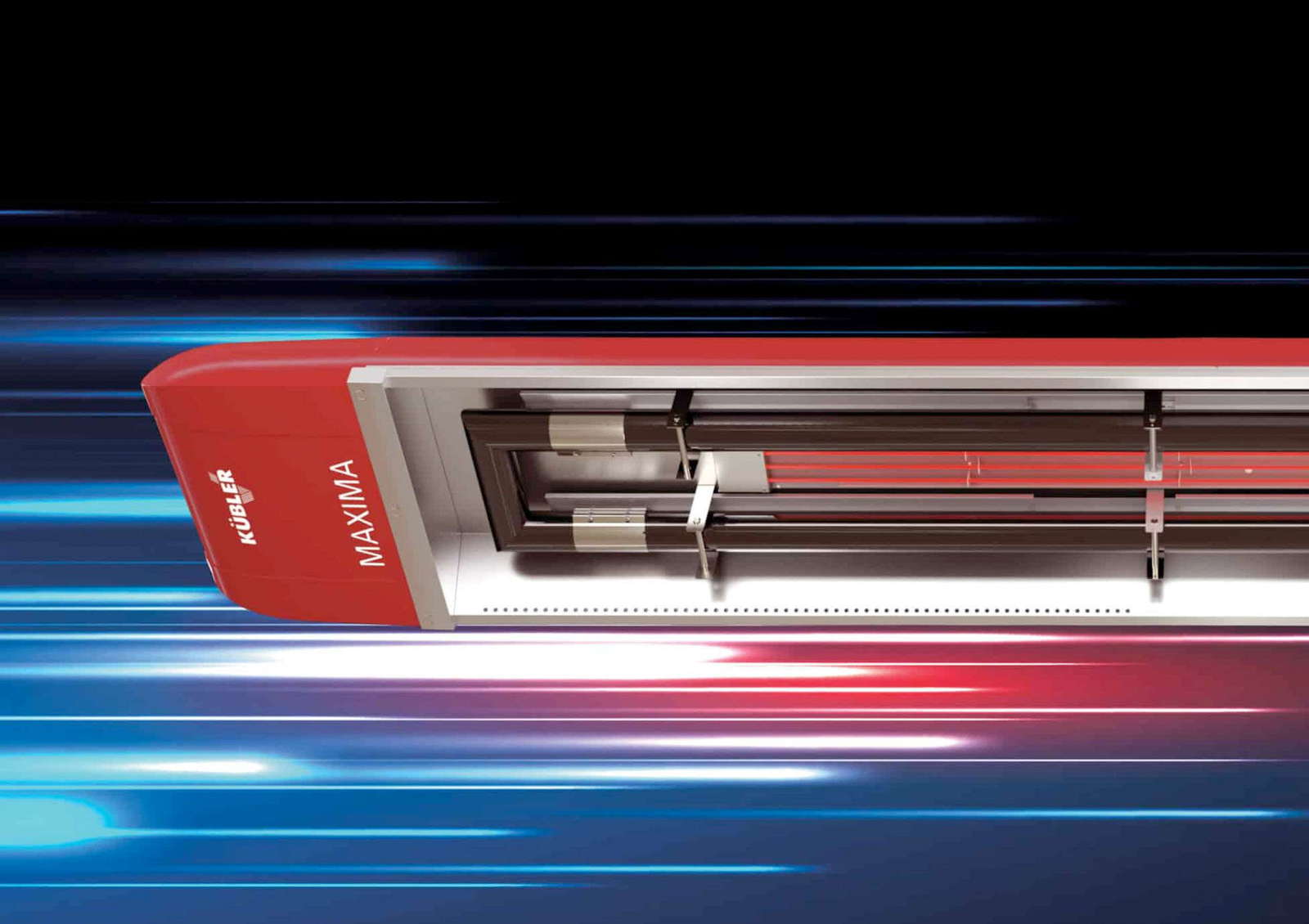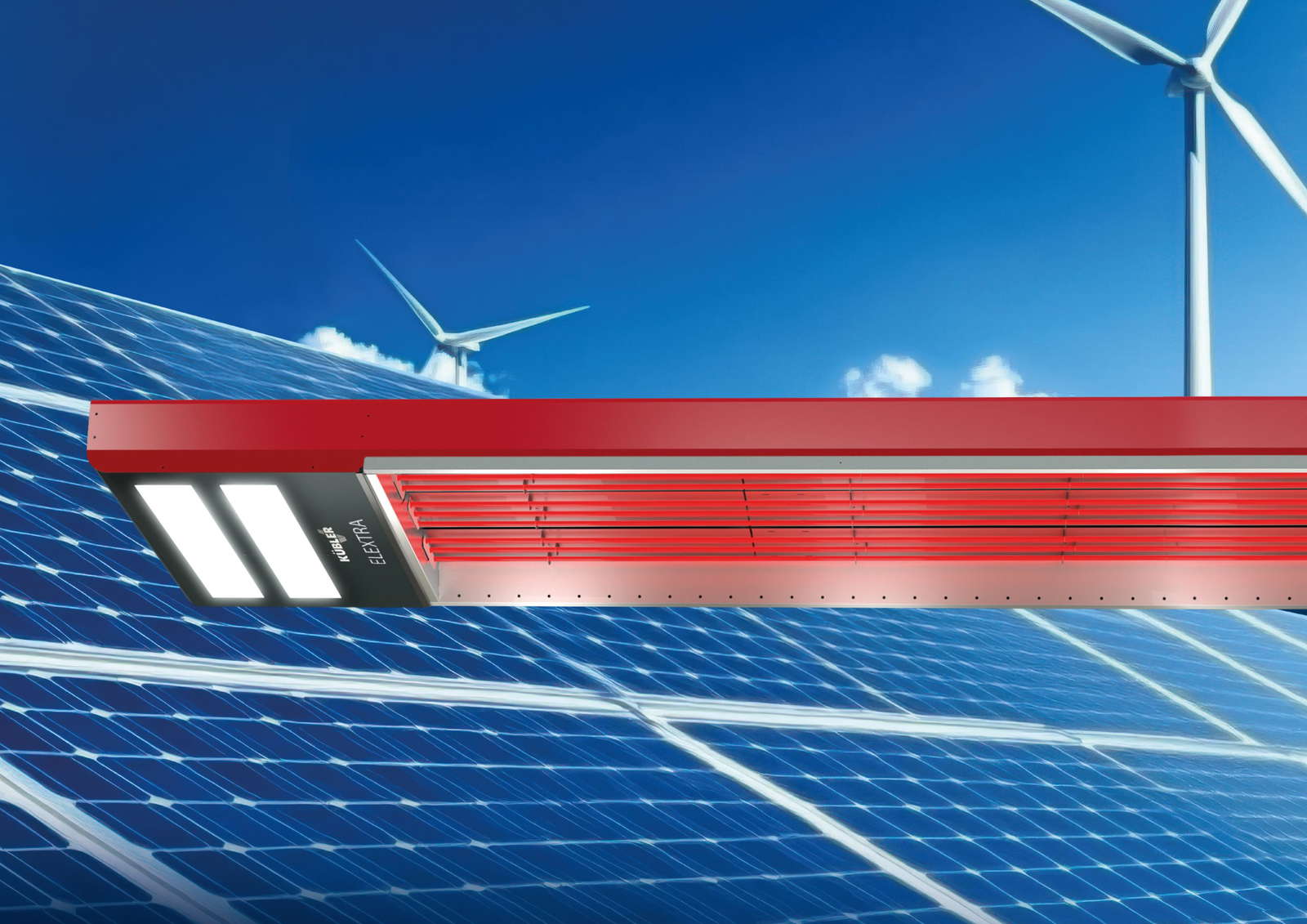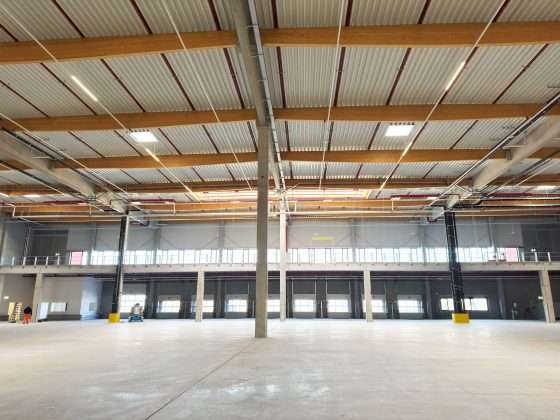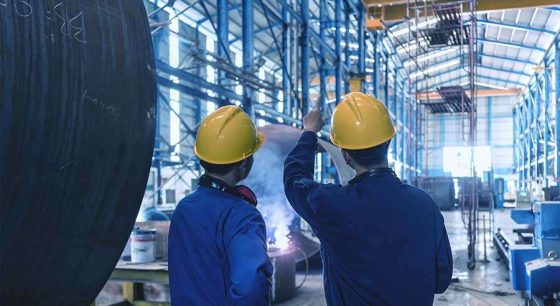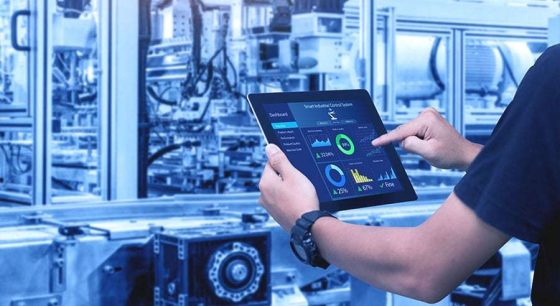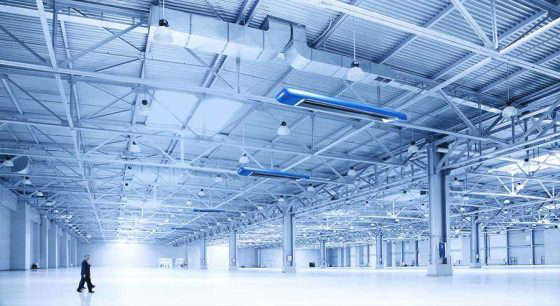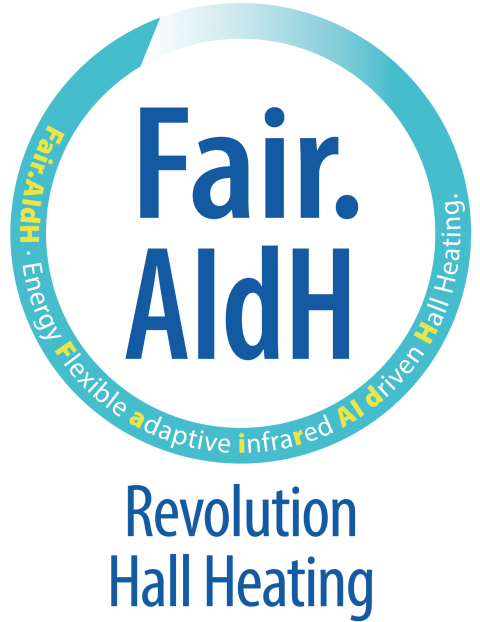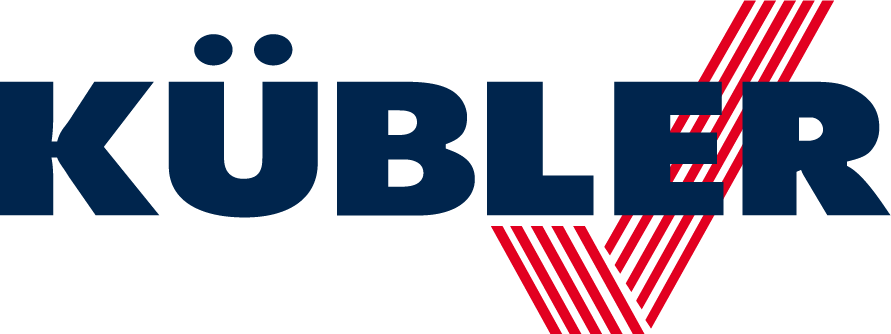Heizungsgesetz (GEG) bei Hallenheizungen
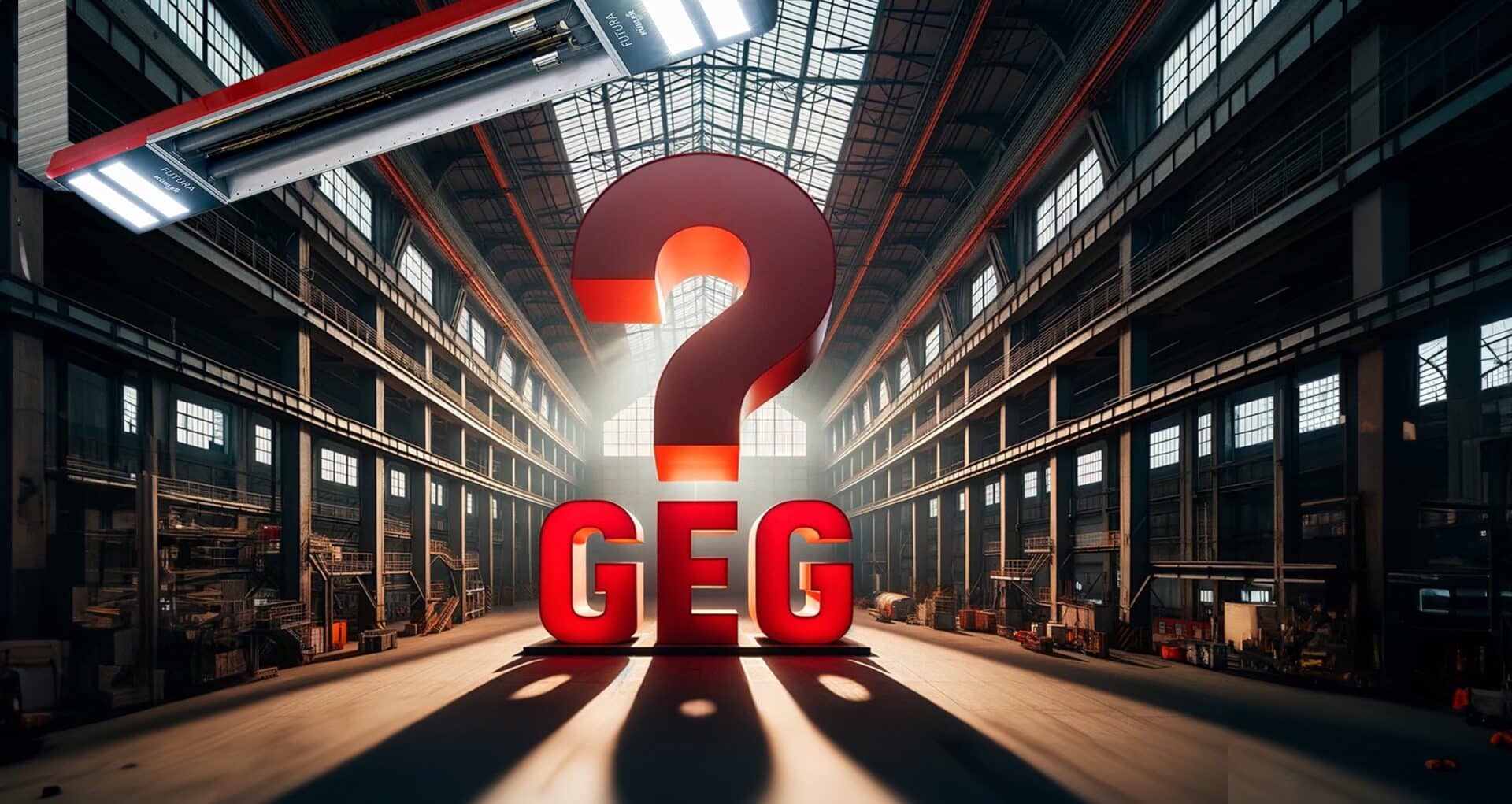
Industriehallen GEG konform heizen. Jetzt. Und nach 2045.
The most important things first
- Hocheffiziente dezentrale Infrarotheizungen sind weiterhin die Hallenheizungs-Technik der ersten Wahl. Das gilt auch nach Inkrafttreten der GEG Novelle. Als innovative, energieflexible Multi-Energie- oder E-Hybrid-Systeme (Fair.AIdH-Technik) können sie alle Anforderungen an den Einsatz Erneuerbarer Energien erfüllen.
- The path to climate-neutral heating is a gradual one. The legislator has provided for generous transition periods, technological openness and pragmatic, affordable regulations in the GEG.
- Until June 30, 2026 (or June 30, 2028), you can renovate your existing system cost-effectively without additional requirements and convert it to future-oriented, energy-saving infrared technology.
I. Was gilt allgemein?
What is the GEG?
The Building Energy Act (GEG) - also known as the Heating Act - is a central component of the German heating transition. It stipulates the energy requirements that heated and air-conditioned buildings must meet. The law came into force on November 1, 2020 and replaces the Energy Saving Act (EnEG), Energy Saving Ordinance (EnEV) and Renewable Energies Heat Act (EEWärmeG). A slight change was made on January 1, 2023 (reduction of the permissible annual primary energy requirement in new buildings from the previous 75 percent of the reference building to 55 percent). A comprehensive amendment to the GEG was passed in the Bundestag on September 8, 2023 after lengthy and controversial debates.
Mit dem neuen Heizungsgesetz hat die Ampelregierung den Umstieg auf klimafreundliche Heizungen eingeleitet. Ziel der Gesetzesnovelle ist es, die Wärmwende in Deutschland schneller voranzutreiben. Gleichzeitig soll die Abhängigkeit von Importen fossiler Energie verringert werden.
What are the requirements of the new GEG?
The Heating Act places new demands on heating and air conditioning technology in terms of:
- Use of renewable energies (RE)
- Energy efficiency
The switch to a climate-friendly heat supply should take place gradually, be plannable in the medium to long term and be cost-effective and stable. The aim is to end the use of fossil fuels in buildings by 2045 at the latest and achieve climate neutrality.
Who is affected by the new heating law?
The new GEG applies to almost all buildings that are heated or air-conditioned. In addition to residential buildings, this also includes non-residential buildings such as halls. Exceptions are
- Greenhouses
- Stable facilities
- Tents
- et al.
Seit wann ist das Heizungsgesetz in Kraft – welche Übergangsfristen gelten?
Different deadlines apply to the fundamental goal of only installing heating systems based on 65% renewable energy wherever possible. It is important to note that the deadline of 01.01.2024 applies to only new buildings in new development areas. For all others:
- 30.06.2026 - New buildings outside new development areas and for existing buildings in large cities (more than 100,000 inhabitants)
- 30.06.2028 - New buildings outside new development areas and for existing buildings in smaller towns
Die bereits seit 1. Januar 2023 gültigen Änderungen beinhalten insbesondere die Reduzierung des zulässigen Jahres-Primärenergiebedarfs im Neubau auf 55 Prozent des Referenzgebäudes sowie die Einführung eines Primärenergiefaktors für Strom zum Betrieb von wärmenetzgebundenen Großwärmepumpen (1,2 für den nicht erneuerbaren Anteil; § 22 Abs. 2 S. 3).
What applies to existing heating systems?
Existing heating systems are not affected by the new Heating Act. This applies to all systems that were or will be installed in new development areas before January 1, 2024 or outside of new development areas before the cut-off dates of June 30, 2026 in municipalities with a population of at least 100,000 and June 30, 2028 in smaller municipalities. In principle, they can continue to be operated and repaired - even if they are oil or gas-fired.
However, systems that are 30 years old and older are affected (§ 72). However, exceptions also apply here, e.g. if the heating systems have a rated output of less than 4 or more than 400 kW. Or if low-temperature or condensing boilers are in use.
However, whether it is worth continuing to operate the system must be examined in detail. This is because the new requirements for the use of much more efficient heating systems or heating systems powered by renewable energies not only help to protect the climate: old systems often cause such high consumption costs that replacing them is also advisable from an economic point of view.
How is the replacement of old heating systems regulated?
It is important to note that heating systems installed before 2024 (or June 30, 2026/2028) can still be operated with up to 100 percent fossil natural gas until December 31, 2044 at the latest. Whether municipal heating planning plays a role here should be examined on a case-by-case basis.
Heating systems that are operated with a liquid or gaseous fuel and were installed before 1991 or are more than 30 years old are generally subject to replacement. Exceptions apply to low-temperature boilers and condensing boilers as well as heating systems with a nominal output of less than 4 or more than 400 kW (§ 72).
Technology openness is the keyword if you want to switch to heating with 65 percent renewable energy. You have a free choice between various technical solutions, for example:
- Connection to a heating network
- Electric heat pump
- Direct electric heating
- Hybrid heating (combination of renewable heating with gas or oil)
- Heating on the basis of solar thermal energy
- „H₂-Ready“-Gasheizungen, also Heizungen, die auf 100 Prozent Wasserstoff umrüstbar sind. Voraussetzung dafür ist, dass es einen rechtsverbindlichen Investitions- und Transformationsplan für eine entsprechende Wasserstoffinfrastruktur vor Ort gibt.
What needs to be considered in the event of a heating system breakdown?
Existing gas or oil heating systems may continue to be operated under the new GEG. If the heating system breaks down, it may be repaired. In the event of a heating system breakdown, i.e. if the system is irreparable, the legislator provides for pragmatic transitional solutions and transitional periods of several years. In cases of hardship, owners can be exempted from the obligation to heat with renewable energies.
What subsidies will be available?
The new funding guidelines are still being voted on in parliament. They are part of the federal subsidy for energy-efficient buildings (BEG). The Federal Ministry for Economic Affairs and Climate Protection (BMWK) promotes "energy consulting for residential buildings" and covers up to 80 percent of the consulting costs. The subsidies for non-residential buildings and "energy advice for non-residential buildings" have not yet been determined.
II. Was gilt speziell für Industrie- und Gewerbehallen?
How is the replacement of hall heating systems in existing buildings regulated?
For highly efficient decentralized hall heating systems, there will still be a need to install them after 2026 (or 2028). No obligation to use renewable energies, wenn zwei Jahre nach dem Einbau eines dezentralen Heizungssystems in Hallen (> 4 m) die Energieeffizienz-Anforderung von mindestens 40 Prozent Einsparung über den Zeitraum eines Jahres nachgewiesen wird (§ 71 m). Das bedeutet: diese Hocheffizienzsysteme (z. B. KÜBLER Technologien) können theoretisch bis zum Stichtag 31.12.2044 ohne Erneuerbare Energien betrieben werden.
What do you need to consider when building a new hall?
The legislator has generally kept the fulfillment of the GEG requirements open to all technologies. There are various compliance options for heating hall buildings with decentralized infrared heating systems:
Requirements for renewable energies:
- Direct electric heaters: Infrared heaters powered directly by electricity that can completely cover the heat requirement. In the hall area none The minimum requirements for structural thermal insulation must be undercut by 45 percent (Section 71d (4)).
- H₂-ready: Gasbetriebene Infrarotheizungen, die spätestens 2045 in der Lage sind, 100 Prozent Wasserstoff zu verbrennen. Bis dahin kann unter Einhaltung eines Transformationspfades nach § 71k weiterhin Erdgas genutzt werden. Die Heizungen dürfen bis zum Ablauf der Fristen für die Wärmeplanung (30. Juni 2026 in Kommunen ab 100.000 Einwohner, 30. Juni 2028 in Kommunen bis 100.000 Einwohner) weiterhin neu eingebaut werden. Allerdings müssen diese ab 2029 einen wachsenden Anteil an Erneuerbaren Energien wie Biogas oder Wasserstoff nutzen:
- 2029: at least 15 percent
- 2035: at least 30 percent
- 2040: at least 60 percent
- 2045: 100 percent
Efficiency requirements:
- Since January 1, 2023, new hall buildings must be constructed in such a way that the annual primary energy requirement (heating, hot water, ventilation, cooling, lighting) does not exceed 0.55 times the primary energy requirement of a reference building. This is easily possible if modern infrared technologies are used and the other trades (building envelope, ventilation, cooling, lighting) are well designed.
- Offsetting PV electricity: Compliance with the efficiency requirements is supported by the regulation that PV electricity generated close to the building can be deducted from the primary energy requirement. In the case of direct electricity heating systems, the calculation is based on a monthly balance (for all trades). This means that the monthly yield of the PV system is offset against the actual electricity requirement.
What obligations apply in hall buildings for control, energy management and building automation?
Non-residential buildings such as halls with a nominal output of the heating system ≥ 290 kW must be equipped with a building automation and control system and digital energy monitoring technology by the end of December 31, 2024 (Section 71a). This requirement is met for decentralized infrared heating systems by the CELESTRA control system and the EMMA energy management system. Important: EMMA is listed as eligible energy management software by BAFA.
What do you need to know when heating halls?
Hall buildings - industrial, commercial or municipal - with ceiling heights of up to 40 m and room dimensions of several thousand square meters are subject to different building physics laws than other non-residential buildings (offices, kindergartens, restaurants, etc.) or even residential buildings.
Für die Beheizung von Hallen ist dezentrale Infrarottechnologie die Technologie der ersten Wahl. Bei der Beheizung dieses speziellen Gebäudesegments ist diese Technologie gegenüber Wärmepumpen mit weitem Abstand überlegen. Dafür gibt es gute Gründe:
- Specially tailored to the special features of halls/hall use: Infrared heaters offer outstanding heating comfort - without draughts and dust turbulence. They have demand-oriented functionalities such as targeted zone heating, automatic switch-off when doors are open and much more.
- Up to 70-80 percent lower investment costs - with comparable efficiency: the significantly lower investment costs and low operating costs make the transformation affordable for industry - an important catalyst for the success of the energy transition.
- Energy efficiency on a par with heat pumps (or better): IR heating systems deliver energy savings of up to 70 percent - even under the most difficult conditions in high hall buildings.
- Installed under the hall ceiling to save space: therefore free (re)use of the hall floor, e.g. for heavy loads, modified machine installations, etc. Flexible for extensions or new installations in other (parts of) buildings.
- Energieflexibel mit erneuerbaren Energien betreibbar (Multi-Energie-Fähigkeit): moderne dezentrale IR-Systeme können wahlweise zwischen den Energieträgern Strom, Wasserstoff, Biogas, (biogenes) Flüssiggas und/oder Methan hin- und herschalten. Das ist bei der unsicheren Verfügbarkeit und Volatilität erneuerbarer Energien für die Betriebssicherheit und Produktivität in der Industrie hochrelevant.
- Energiemanagement und vollständige Digitalisierung: digital gesteuert ist der Betrieb der Heizungsanlage stets auf optimalem Effizienzniveau. Das Energiemanagement schafft Transparenz und ist Grundlage für Audits, z. B. nach DIN EN ISO 50001.
How can modern KÜBLER infrared heaters be used in compliance with the GEG?
In existing buildings, highly efficient infrared heaters such as the KÜBLER MAXIMA or PRIMA plus technologies are easily used in compliance with the GEG due to their high energy savings of 40 percent and more.
Im Neubau bietet die Fair.AIdH-Technologie – die mehrfach ausgezeichnete Infrarotheizung FUTURA von KÜBLER – gleich zwei Erfüllungsoptionen für die EE-Anforderungen. Sie ist beides: Stromdirektheizung und H₂-ready. Und wenn Ihre Heizstrategie auf Strom basiert: FUTURA E und ELEXTRA begleiten Sie zukunftssicher und wirtschaftlich in die carbonfreie Zeit.
The innovative KÜBLER technologies can also meet the high efficiency requirements in new buildings (55 percent of the reference building) in the interaction of all trades (building envelope, ventilation, cooling, lighting).
And the bottom line?
Highly efficient decentralized infrared heaters are considered the golden standard for heating industrial halls. No wonder, because they are specifically designed to supply heat to these building giants. Infrared heaters from KÜBLER are regarded as the most efficient and economical solutions on the market. They have received numerous awards for their contribution to the energy transition and perfectly fulfill the three essential requirements for modern hall heating systems:
- Energy efficiency & renewable energies
- Thermal comfort & functionality
- Economy & flexibility
KÜBLER Technologien setzen in allen wesentlichen Punkten die Maßstäbe und begleiten Sie investitions- und rechtssicher durch den gesamten Transformationsweg der Energiewende – von jetzt bis über 2045 hinaus.
Antworten auf Ihre Fragen zum GEG und wie Sie Ihre Hallen gesetzeskonform heizen, erhalten Sie unter +49 621 57000-0 oder schreiben Sie eine Mail an kontakt@kuebler-hallenheizungen.de Our experts will advise you competently and without obligation!
Sources:
BMWK - Switch to climate-friendly heat now! (energiewechsel.de)
BMWK - Renewable heating - Building Energy Act (GEG) (energiewechsel.de)
-
Hot air, panel heating or infrared? There are many different heating systems to choose from for heating halls. This article will give you an initial overview of the six most relevant systems.
-
Operators of indoor heating systems are also responsible for having their system serviced regularly. In addition to operational safety, there are other good reasons why maintenance should not be put on the back burner!
-
The topic of Industry 4.0 is no longer a dream of the future. The digitalization of industrial processes is being talked about everywhere - and a new era has also dawned in the heating supply sector. Find out in this article what intelligent networking looks like for heating building complexes and what opportunities it opens up for you!
-
If you are reading this article, you are probably looking for an efficient way to heat your industrial or commercial building. During your research, you have already come across one or other technology such as dark radiant heaters or hot air. Now you want to know why dark radiant heaters in particular are repeatedly highlighted as especially efficient. We'll tell you!
